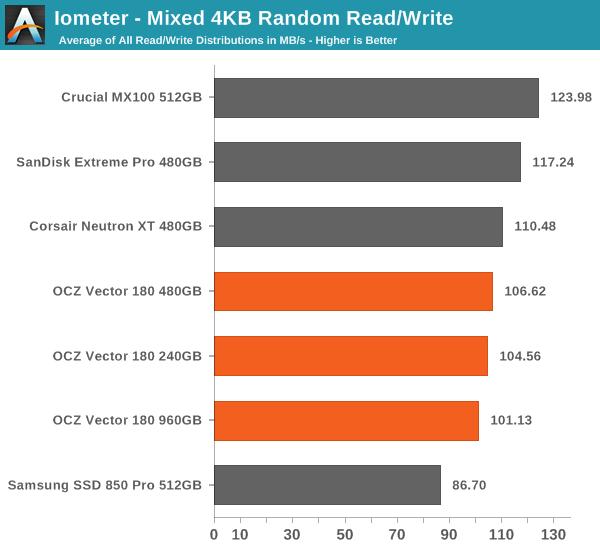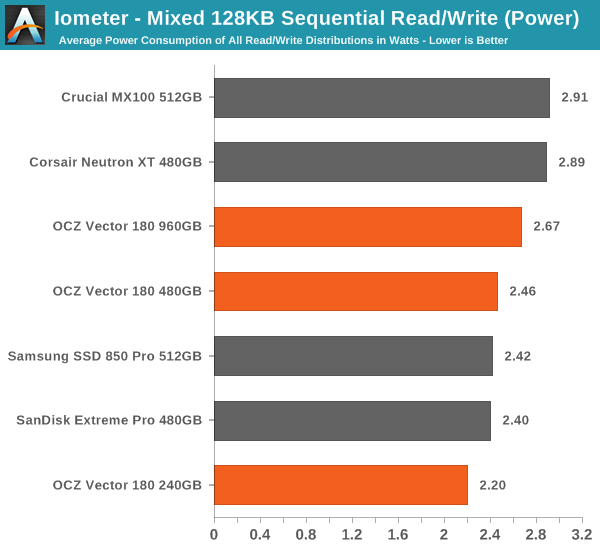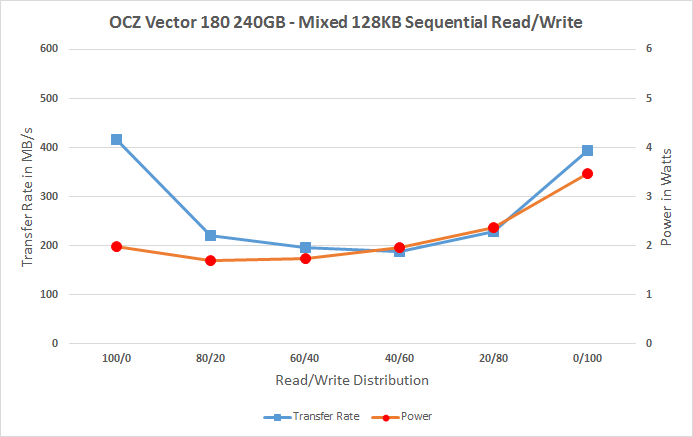The OCZ Vector 180 (240GB, 480GB & 960GB) SSD Review
by Kristian Vättö on March 24, 2015 2:00 PM EST- Posted in
- Storage
- SSDs
- OCZ
- Barefoot 3
- Vector 180
Mixed Random Read/Write Performance
Mixed read/write tests are also a new addition to our test suite. In real world applications a significant portion of workloads are mixed, meaning that there are both read and write IOs. Our Storage Bench benchmarks already illustrate mixed workloads by being based on actual real world IO traces, but until now we haven't had a proper synthetic way to measure mixed performance.
The benchmark is divided into two tests. The first one tests mixed performance with 4KB random IOs at six different read/write distributions starting at 100% reads and adding 20% of writes in each phase. Because we are dealing with a mixed workload that contains reads, the drive is first filled with 128KB sequential data to ensure valid results. Similarly, because the IO pattern is random, I've limited the LBA span to 16GB to ensure that the results aren't affected by IO consistency. The queue depth of the 4KB random test is three.
Again, for the sake of readability, I provide both an average based bar graph as well as a line graph with the full data on it. The bar graph represents an average of all six read/write distribution data rates for quick comparison, whereas the line graph includes a separate data point for each tested distribution.

The Vector 180 does better in mixed 4KB random IO than the 850 Pro, but it's a bit slower than the rest of the drives.

Fortunately the power consumption is still excellent.
 |
|||||||||
Vector 180's problem is its low random read performance because the performance gets better as more writes are thrown into the mix.
Mixed Sequential Read/Write Performance
The sequential mixed workload tests are also tested with a full drive, but I've not limited the LBA range as that's not needed with sequential data patterns. The queue depth for the tests is one.

In mixed sequential tests the Vector 180 does slightly better in the sense that the difference between drives in the order of 10% when excluding the 850 Pro.

Similar to what we saw in the sequential tests, the write power consumption is fairly high, which also increases the average power consumption and the Vector 180 no longer enjoys an advantage over the other drives.
 |
|||||||||
Vector 180's "bathtub" curve is pretty average, but as we can see here the power scales as soon as the portion of writes is increased, which isn't unique but for instance the 850 Pro and Extreme Pro don't exhibit such behavior.










89 Comments
View All Comments
nils_ - Wednesday, March 25, 2015 - link
I distinctly remember that when I replaced a SSD in my workstation the Acronis tool, instead of copying my data from the source SSD to the new SSD copied the data to another, unrelated HDD in the system, happily overwriting the Linux partitions stored thereon... I had to unplug everything from the mainboard safe for the old and new SSD to make sure that it doesn't destroy any more of my data.MikeMurphy - Wednesday, March 25, 2015 - link
Macrium Reflect is free and wonderful to use.mapesdhs - Wednesday, March 25, 2015 - link
Yep, MR is what I use, it works very well and has a good interface.
Ian.
JonnyDough - Tuesday, March 31, 2015 - link
Thirded. It works wonderfully.The_Assimilator - Tuesday, March 24, 2015 - link
OCZ is still beating that Barefoot 3 dead horse for all it's worth. No wonder they went bankrupt. If you don't innovate, you die.ocztosh - Tuesday, March 24, 2015 - link
Hello The_Assimilator. Thanks for your comments. Innovation is definitely a key area of focus for us on both the client and enterprise sides of our SSD business. We currently have a lot of resources put on next generation controllers and have been working hard on client SSDs leveraging the latest Toshiba NAND flash, which includes TLC. While some of these products are on the horizon it was natural for us to update our Vector Series with A19 NAND flash, and rather than just make a NAND change we wanted to add new features not normally found in our client class products like power fail management plus (PFM+) to further improve reliability in applications that blur the line between enthusiast and workstation.It is true that Barefoot 3 has, and continues to be, a very strong platform for us as we have shipped so many drives based on this in-house controller, and it has been so solid that we have not had to rev silicon a single time. We will continue to push to innovate when it comes to SSD performance, features and cost and are committed to delivering more value for all our customers. Thanks again for your feedback.
Minion4Hire - Tuesday, March 24, 2015 - link
The bigger problem is that the SSD market has stagnated. When their weren't major players (like Samsung) the little guy could cobble something together and make a decent living filling what was a niche market. Now SSDs are mainstream, and through volume alone the big guys can overpower the little guys, let alone R&D, etc. Until the market shifts away from SATA there's no room for niche innovation or clever advances. It's all down to margins right now.Samus - Tuesday, March 24, 2015 - link
You do realize the two best-selling controllers are Marvell and Sandforce, and both are older than Barefoot 3. The SF2281 is 3+ years old and still ships in a variety of Mushkin, ADATA, Intel, etc SSD's.Barefoot 3 is thoroughly modern, but it does lack some power saving and drive encryption features. I don't think it makes sense for OCZ to update it when PCIe is around the corner and will require a new controller since a bridge will be expensive and not much faster.
Aside from that, Barefoot 3 is incredibly innovative. I consider it the best controller available aside from Intel's 3rd gen controller (equally as old) and Samsung's MEX. ASMedia is still a little inconsistent and featureless, Marvell has an aging indirection table implementation that yields average performance, Phison is clearly entry-level with relatively low performance and consistency, Silicon Motion and Fusion-IO are power hungry, have quirks with certain NAND varieties and are not cost competitive.
Guspaz - Tuesday, March 24, 2015 - link
"There's an old saying in Tennessee - I know it's in Texas, probably in Tennessee - that says, fool me once, shame on - shame on you. Fool me - you can't get fooled again."Yeah, George, I'm not planning on getting fooled by OCZ again.
blue_urban_sky - Tuesday, March 24, 2015 - link
Is that the saying from Tennessee where they cant't remember the proper saying?